Literature Review on Babesia Infection in Humans
VerifiedAdded on 2023/06/07
|13
|4486
|317
AI Summary
This literature review explores the impact of Babesia disease on humans, including its transmission, clinical and pathological features, treatment options, and current advancements in detection and treatment. It also discusses the emergence and prevalence of Babesia in the UK.
Contribute Materials
Your contribution can guide someone’s learning journey. Share your
documents today.

Literature Review
Secure Best Marks with AI Grader
Need help grading? Try our AI Grader for instant feedback on your assignments.
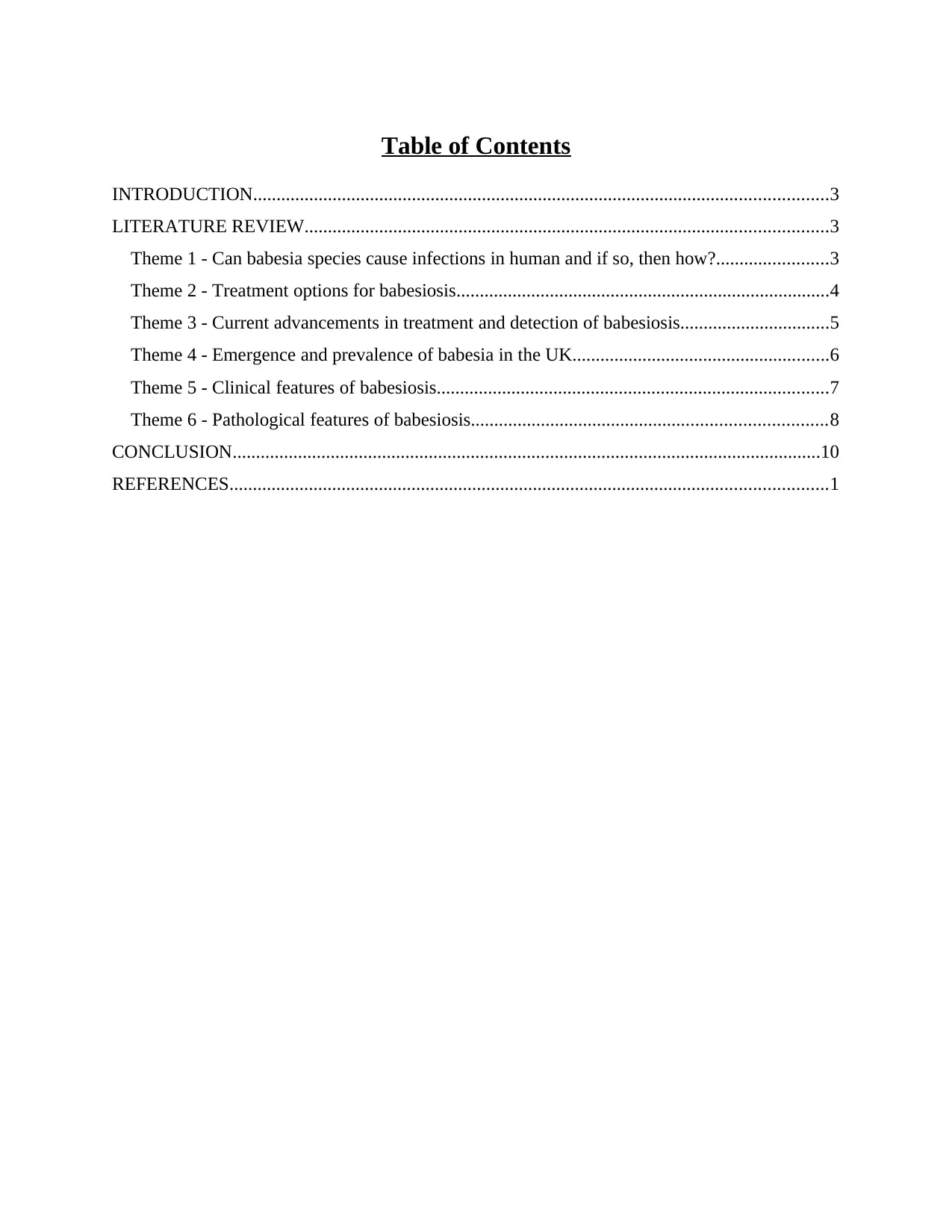
Table of Contents
INTRODUCTION...........................................................................................................................3
LITERATURE REVIEW................................................................................................................3
Theme 1 - Can babesia species cause infections in human and if so, then how?........................3
Theme 2 - Treatment options for babesiosis................................................................................4
Theme 3 - Current advancements in treatment and detection of babesiosis................................5
Theme 4 - Emergence and prevalence of babesia in the UK.......................................................6
Theme 5 - Clinical features of babesiosis....................................................................................7
Theme 6 - Pathological features of babesiosis............................................................................8
CONCLUSION..............................................................................................................................10
REFERENCES................................................................................................................................1
INTRODUCTION...........................................................................................................................3
LITERATURE REVIEW................................................................................................................3
Theme 1 - Can babesia species cause infections in human and if so, then how?........................3
Theme 2 - Treatment options for babesiosis................................................................................4
Theme 3 - Current advancements in treatment and detection of babesiosis................................5
Theme 4 - Emergence and prevalence of babesia in the UK.......................................................6
Theme 5 - Clinical features of babesiosis....................................................................................7
Theme 6 - Pathological features of babesiosis............................................................................8
CONCLUSION..............................................................................................................................10
REFERENCES................................................................................................................................1

INTRODUCTION
Babesia is an illness which is transmitted through ticks that gets in contact with this illness
while feeding on rodents, infected cattle etc. and have a negative impact on the red blood cells of
the human body (Al-Nazal and et.al., 2022).
The present literature review aims to determine the previous researches by authors on the
impact on babesia disease on humans. The first theme explains that how Babesia species can
cause infections in humans. The next theme describes various treatment options for babesiosis.
Also, the another theme analyses the current advancements in detection and treatment of
babesiosis. The next theme evaluates prevalence and emergence of babesia in the UK region.
Further, another theme discusses the clinical features of babesiosis and the final theme explains
the pathological features of babesiosis.
LITERATURE REVIEW
Theme 1 - Can babesia species cause infections in human and if so, then how?
According to Goethert, (2021), Babesiosis is a severe disease which is spread through
protozoa which belong to the Babesia family. It is found that ticks carry the Babesia protozoa
and transmit the disease to living beings. Al-Nazal and et.al., (2022) explained that this disease
can be caused in human in rare cases where two of the species from the Babesia family can
certainly spread this disease. Babesia microti and Babesia divergens are the species which are
responsible for spreading this disease majorly in the humans. Further, it has been stated by Gray
and Ogden, (2021) that Babesia protozoa for example the Babesia microti is transmitted through
the bite of ticks that are infected. This bite can have a severe impact on the health conditions of
humans as it may not be known to the human body. These ticks act as vectors which acts a
disease agent and spreads a particular disease or infection in living organisms.
However, Schnittger and et.al., (2022) argued that Babesia is a rare disease which is
mostly caused in animal species and cannot be transmitted in humans. The author suggests that
the health conditions which has been faced in UK may be confused with any other disease which
is of another kind. But, Kumar, O’Bryan and Krause, (2021) found that this is not true and there
is a special condition where this disease can be transmitted to humans and can cause major harm
to them. Mild symptoms of headache, fever, vomiting or nausea can be experienced in humans
due to Babesiosis which may create discomfort for people. According to Scott and et.al., (2021),
Babesia is an illness which is transmitted through ticks that gets in contact with this illness
while feeding on rodents, infected cattle etc. and have a negative impact on the red blood cells of
the human body (Al-Nazal and et.al., 2022).
The present literature review aims to determine the previous researches by authors on the
impact on babesia disease on humans. The first theme explains that how Babesia species can
cause infections in humans. The next theme describes various treatment options for babesiosis.
Also, the another theme analyses the current advancements in detection and treatment of
babesiosis. The next theme evaluates prevalence and emergence of babesia in the UK region.
Further, another theme discusses the clinical features of babesiosis and the final theme explains
the pathological features of babesiosis.
LITERATURE REVIEW
Theme 1 - Can babesia species cause infections in human and if so, then how?
According to Goethert, (2021), Babesiosis is a severe disease which is spread through
protozoa which belong to the Babesia family. It is found that ticks carry the Babesia protozoa
and transmit the disease to living beings. Al-Nazal and et.al., (2022) explained that this disease
can be caused in human in rare cases where two of the species from the Babesia family can
certainly spread this disease. Babesia microti and Babesia divergens are the species which are
responsible for spreading this disease majorly in the humans. Further, it has been stated by Gray
and Ogden, (2021) that Babesia protozoa for example the Babesia microti is transmitted through
the bite of ticks that are infected. This bite can have a severe impact on the health conditions of
humans as it may not be known to the human body. These ticks act as vectors which acts a
disease agent and spreads a particular disease or infection in living organisms.
However, Schnittger and et.al., (2022) argued that Babesia is a rare disease which is
mostly caused in animal species and cannot be transmitted in humans. The author suggests that
the health conditions which has been faced in UK may be confused with any other disease which
is of another kind. But, Kumar, O’Bryan and Krause, (2021) found that this is not true and there
is a special condition where this disease can be transmitted to humans and can cause major harm
to them. Mild symptoms of headache, fever, vomiting or nausea can be experienced in humans
due to Babesiosis which may create discomfort for people. According to Scott and et.al., (2021),

Babesia can be threat to life in a condition where a patient has removed their spleens or with an
unstable immune system. This may lead towards serious repercussions for the patients as their
ability to fight with this disease can become less in this condition. Low level of white blood cells
and platelets can be experienced in the patients which have been diagnosed with babesiosis.
As per the views of Shah and Ramasamy, (2022), Babesiosis is an infectious disease
which has an equal negative impact on the healthcare of males and females of UK. This disease
has a potentially severe impact on the patients that are above the age group of 50 years. These
individuals may have competitively weaker immune systems and are prone to more diseases than
the younger ones. According to Kumar, O’Bryan and Krause, (2022), the babesia species has
caused a comparatively severe form of babesiosis in UK in comparison with other nations which
are dealing with the effects of this issue. The major impact of this disease has been on the
domesticated animals through ticks which acts as vectors of this disease. Similarly, Garden and
et.al., (2019) suggests that there are fewer possibilities of infections in humans due to the spread
of Babesia disease as it is commonly related with animals but due consideration is to be given for
the people that are having their spleen removed.
Theme 2 - Treatment options for babesiosis
According to Clark, (2021), Babesiosis has a weaker impact on the healthcare of humans
and may cause negligible or very less harm in the majority of the patients. People having
difficulties to manage their immune systems require proper treatment for this disease by using
the quinine, clindamycin or any other suitable drug. Similarly, Chen and et.al., (2019) stated
found that quinine and clindamycin are the most effective drugs which are majorly suggested by
healthcare professionals to the patients which are diagnosed with babesiosis. Studies have shown
that a positive change can be experienced in the health conditions of the patients which are
suffering through this disease. However, Lobo, Singh and Rodriguez, (2020) found that these
drugs may be ineffective in certain severe conditions where people are facing issues that are of
higher degree. These medicines may not be able to provide the patients with maximum relief in
specific conditions where the people are facing issues.
As per the views of Karasová and et.al., (2022), In severe cases where these drugs are
ineffective, azithromycin and atovaquone are suggested to the patients for treated with these
drugs. This treatment may be effective for the patients in order to improve the overall health
unstable immune system. This may lead towards serious repercussions for the patients as their
ability to fight with this disease can become less in this condition. Low level of white blood cells
and platelets can be experienced in the patients which have been diagnosed with babesiosis.
As per the views of Shah and Ramasamy, (2022), Babesiosis is an infectious disease
which has an equal negative impact on the healthcare of males and females of UK. This disease
has a potentially severe impact on the patients that are above the age group of 50 years. These
individuals may have competitively weaker immune systems and are prone to more diseases than
the younger ones. According to Kumar, O’Bryan and Krause, (2022), the babesia species has
caused a comparatively severe form of babesiosis in UK in comparison with other nations which
are dealing with the effects of this issue. The major impact of this disease has been on the
domesticated animals through ticks which acts as vectors of this disease. Similarly, Garden and
et.al., (2019) suggests that there are fewer possibilities of infections in humans due to the spread
of Babesia disease as it is commonly related with animals but due consideration is to be given for
the people that are having their spleen removed.
Theme 2 - Treatment options for babesiosis
According to Clark, (2021), Babesiosis has a weaker impact on the healthcare of humans
and may cause negligible or very less harm in the majority of the patients. People having
difficulties to manage their immune systems require proper treatment for this disease by using
the quinine, clindamycin or any other suitable drug. Similarly, Chen and et.al., (2019) stated
found that quinine and clindamycin are the most effective drugs which are majorly suggested by
healthcare professionals to the patients which are diagnosed with babesiosis. Studies have shown
that a positive change can be experienced in the health conditions of the patients which are
suffering through this disease. However, Lobo, Singh and Rodriguez, (2020) found that these
drugs may be ineffective in certain severe conditions where people are facing issues that are of
higher degree. These medicines may not be able to provide the patients with maximum relief in
specific conditions where the people are facing issues.
As per the views of Karasová and et.al., (2022), In severe cases where these drugs are
ineffective, azithromycin and atovaquone are suggested to the patients for treated with these
drugs. This treatment may be effective for the patients in order to improve the overall health
Secure Best Marks with AI Grader
Need help grading? Try our AI Grader for instant feedback on your assignments.
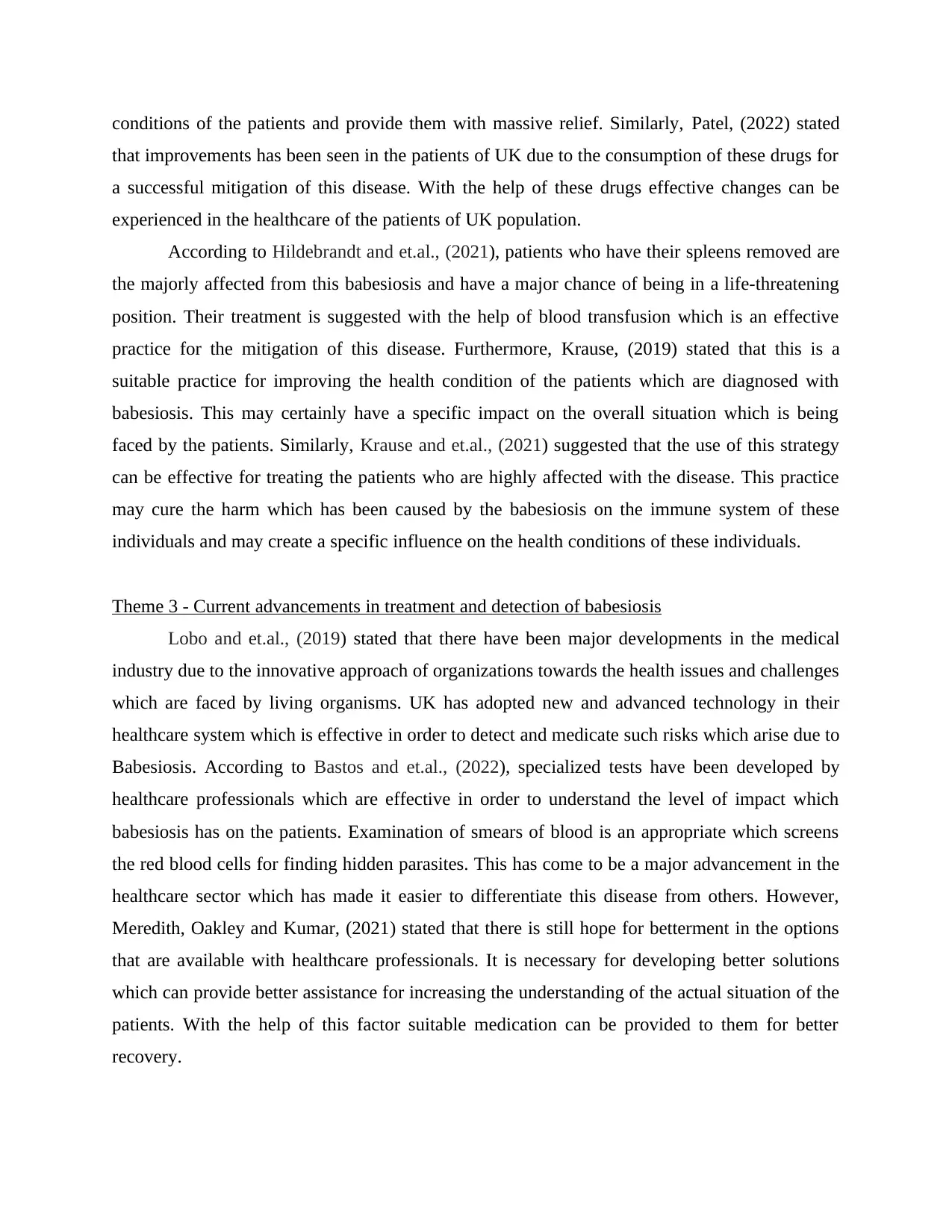
conditions of the patients and provide them with massive relief. Similarly, Patel, (2022) stated
that improvements has been seen in the patients of UK due to the consumption of these drugs for
a successful mitigation of this disease. With the help of these drugs effective changes can be
experienced in the healthcare of the patients of UK population.
According to Hildebrandt and et.al., (2021), patients who have their spleens removed are
the majorly affected from this babesiosis and have a major chance of being in a life-threatening
position. Their treatment is suggested with the help of blood transfusion which is an effective
practice for the mitigation of this disease. Furthermore, Krause, (2019) stated that this is a
suitable practice for improving the health condition of the patients which are diagnosed with
babesiosis. This may certainly have a specific impact on the overall situation which is being
faced by the patients. Similarly, Krause and et.al., (2021) suggested that the use of this strategy
can be effective for treating the patients who are highly affected with the disease. This practice
may cure the harm which has been caused by the babesiosis on the immune system of these
individuals and may create a specific influence on the health conditions of these individuals.
Theme 3 - Current advancements in treatment and detection of babesiosis
Lobo and et.al., (2019) stated that there have been major developments in the medical
industry due to the innovative approach of organizations towards the health issues and challenges
which are faced by living organisms. UK has adopted new and advanced technology in their
healthcare system which is effective in order to detect and medicate such risks which arise due to
Babesiosis. According to Bastos and et.al., (2022), specialized tests have been developed by
healthcare professionals which are effective in order to understand the level of impact which
babesiosis has on the patients. Examination of smears of blood is an appropriate which screens
the red blood cells for finding hidden parasites. This has come to be a major advancement in the
healthcare sector which has made it easier to differentiate this disease from others. However,
Meredith, Oakley and Kumar, (2021) stated that there is still hope for betterment in the options
that are available with healthcare professionals. It is necessary for developing better solutions
which can provide better assistance for increasing the understanding of the actual situation of the
patients. With the help of this factor suitable medication can be provided to them for better
recovery.
that improvements has been seen in the patients of UK due to the consumption of these drugs for
a successful mitigation of this disease. With the help of these drugs effective changes can be
experienced in the healthcare of the patients of UK population.
According to Hildebrandt and et.al., (2021), patients who have their spleens removed are
the majorly affected from this babesiosis and have a major chance of being in a life-threatening
position. Their treatment is suggested with the help of blood transfusion which is an effective
practice for the mitigation of this disease. Furthermore, Krause, (2019) stated that this is a
suitable practice for improving the health condition of the patients which are diagnosed with
babesiosis. This may certainly have a specific impact on the overall situation which is being
faced by the patients. Similarly, Krause and et.al., (2021) suggested that the use of this strategy
can be effective for treating the patients who are highly affected with the disease. This practice
may cure the harm which has been caused by the babesiosis on the immune system of these
individuals and may create a specific influence on the health conditions of these individuals.
Theme 3 - Current advancements in treatment and detection of babesiosis
Lobo and et.al., (2019) stated that there have been major developments in the medical
industry due to the innovative approach of organizations towards the health issues and challenges
which are faced by living organisms. UK has adopted new and advanced technology in their
healthcare system which is effective in order to detect and medicate such risks which arise due to
Babesiosis. According to Bastos and et.al., (2022), specialized tests have been developed by
healthcare professionals which are effective in order to understand the level of impact which
babesiosis has on the patients. Examination of smears of blood is an appropriate which screens
the red blood cells for finding hidden parasites. This has come to be a major advancement in the
healthcare sector which has made it easier to differentiate this disease from others. However,
Meredith, Oakley and Kumar, (2021) stated that there is still hope for betterment in the options
that are available with healthcare professionals. It is necessary for developing better solutions
which can provide better assistance for increasing the understanding of the actual situation of the
patients. With the help of this factor suitable medication can be provided to them for better
recovery.
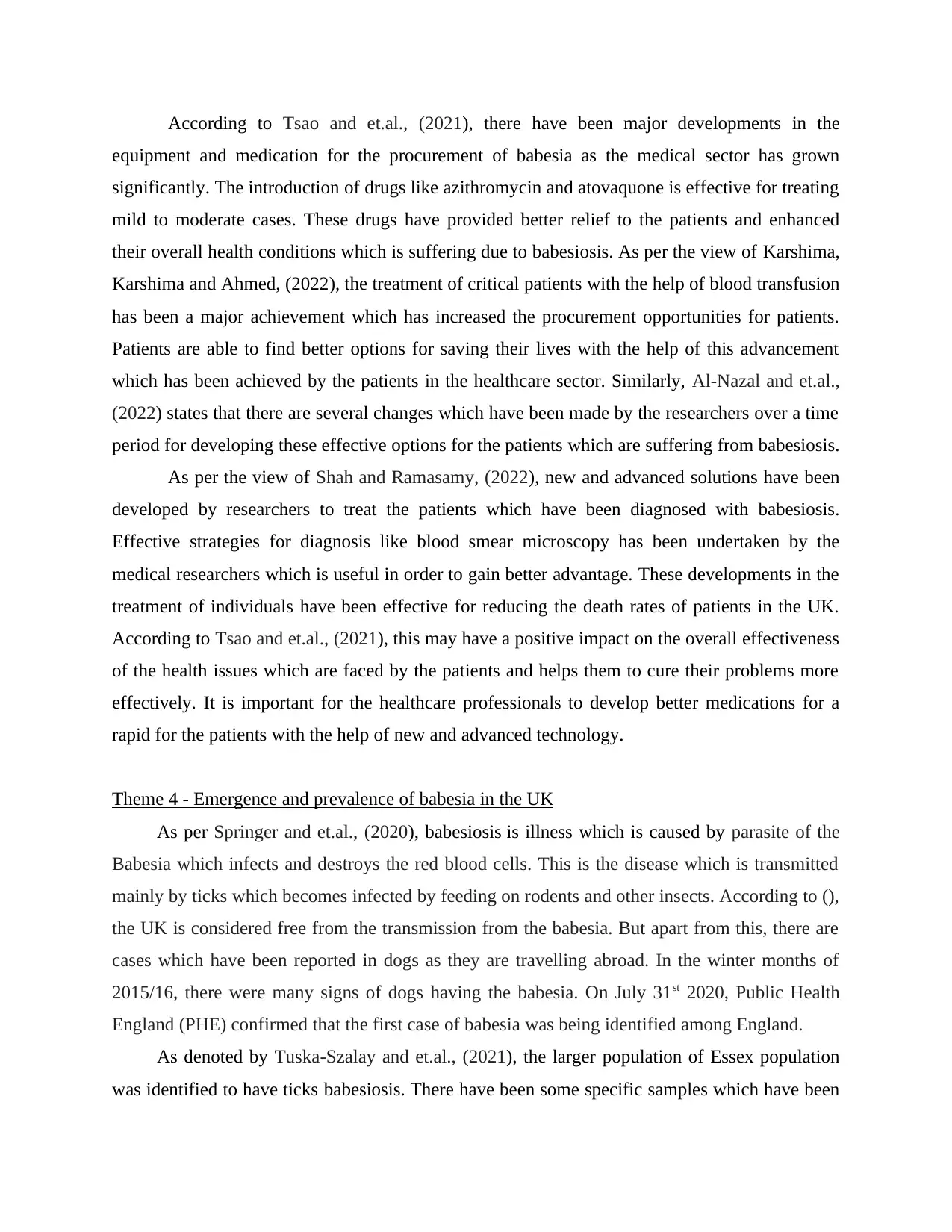
According to Tsao and et.al., (2021), there have been major developments in the
equipment and medication for the procurement of babesia as the medical sector has grown
significantly. The introduction of drugs like azithromycin and atovaquone is effective for treating
mild to moderate cases. These drugs have provided better relief to the patients and enhanced
their overall health conditions which is suffering due to babesiosis. As per the view of Karshima,
Karshima and Ahmed, (2022), the treatment of critical patients with the help of blood transfusion
has been a major achievement which has increased the procurement opportunities for patients.
Patients are able to find better options for saving their lives with the help of this advancement
which has been achieved by the patients in the healthcare sector. Similarly, Al-Nazal and et.al.,
(2022) states that there are several changes which have been made by the researchers over a time
period for developing these effective options for the patients which are suffering from babesiosis.
As per the view of Shah and Ramasamy, (2022), new and advanced solutions have been
developed by researchers to treat the patients which have been diagnosed with babesiosis.
Effective strategies for diagnosis like blood smear microscopy has been undertaken by the
medical researchers which is useful in order to gain better advantage. These developments in the
treatment of individuals have been effective for reducing the death rates of patients in the UK.
According to Tsao and et.al., (2021), this may have a positive impact on the overall effectiveness
of the health issues which are faced by the patients and helps them to cure their problems more
effectively. It is important for the healthcare professionals to develop better medications for a
rapid for the patients with the help of new and advanced technology.
Theme 4 - Emergence and prevalence of babesia in the UK
As per Springer and et.al., (2020), babesiosis is illness which is caused by parasite of the
Babesia which infects and destroys the red blood cells. This is the disease which is transmitted
mainly by ticks which becomes infected by feeding on rodents and other insects. According to (),
the UK is considered free from the transmission from the babesia. But apart from this, there are
cases which have been reported in dogs as they are travelling abroad. In the winter months of
2015/16, there were many signs of dogs having the babesia. On July 31st 2020, Public Health
England (PHE) confirmed that the first case of babesia was being identified among England.
As denoted by Tuska-Szalay and et.al., (2021), the larger population of Essex population
was identified to have ticks babesiosis. There have been some specific samples which have been
equipment and medication for the procurement of babesia as the medical sector has grown
significantly. The introduction of drugs like azithromycin and atovaquone is effective for treating
mild to moderate cases. These drugs have provided better relief to the patients and enhanced
their overall health conditions which is suffering due to babesiosis. As per the view of Karshima,
Karshima and Ahmed, (2022), the treatment of critical patients with the help of blood transfusion
has been a major achievement which has increased the procurement opportunities for patients.
Patients are able to find better options for saving their lives with the help of this advancement
which has been achieved by the patients in the healthcare sector. Similarly, Al-Nazal and et.al.,
(2022) states that there are several changes which have been made by the researchers over a time
period for developing these effective options for the patients which are suffering from babesiosis.
As per the view of Shah and Ramasamy, (2022), new and advanced solutions have been
developed by researchers to treat the patients which have been diagnosed with babesiosis.
Effective strategies for diagnosis like blood smear microscopy has been undertaken by the
medical researchers which is useful in order to gain better advantage. These developments in the
treatment of individuals have been effective for reducing the death rates of patients in the UK.
According to Tsao and et.al., (2021), this may have a positive impact on the overall effectiveness
of the health issues which are faced by the patients and helps them to cure their problems more
effectively. It is important for the healthcare professionals to develop better medications for a
rapid for the patients with the help of new and advanced technology.
Theme 4 - Emergence and prevalence of babesia in the UK
As per Springer and et.al., (2020), babesiosis is illness which is caused by parasite of the
Babesia which infects and destroys the red blood cells. This is the disease which is transmitted
mainly by ticks which becomes infected by feeding on rodents and other insects. According to (),
the UK is considered free from the transmission from the babesia. But apart from this, there are
cases which have been reported in dogs as they are travelling abroad. In the winter months of
2015/16, there were many signs of dogs having the babesia. On July 31st 2020, Public Health
England (PHE) confirmed that the first case of babesia was being identified among England.
As denoted by Tuska-Szalay and et.al., (2021), the larger population of Essex population
was identified to have ticks babesiosis. There have been some specific samples which have been
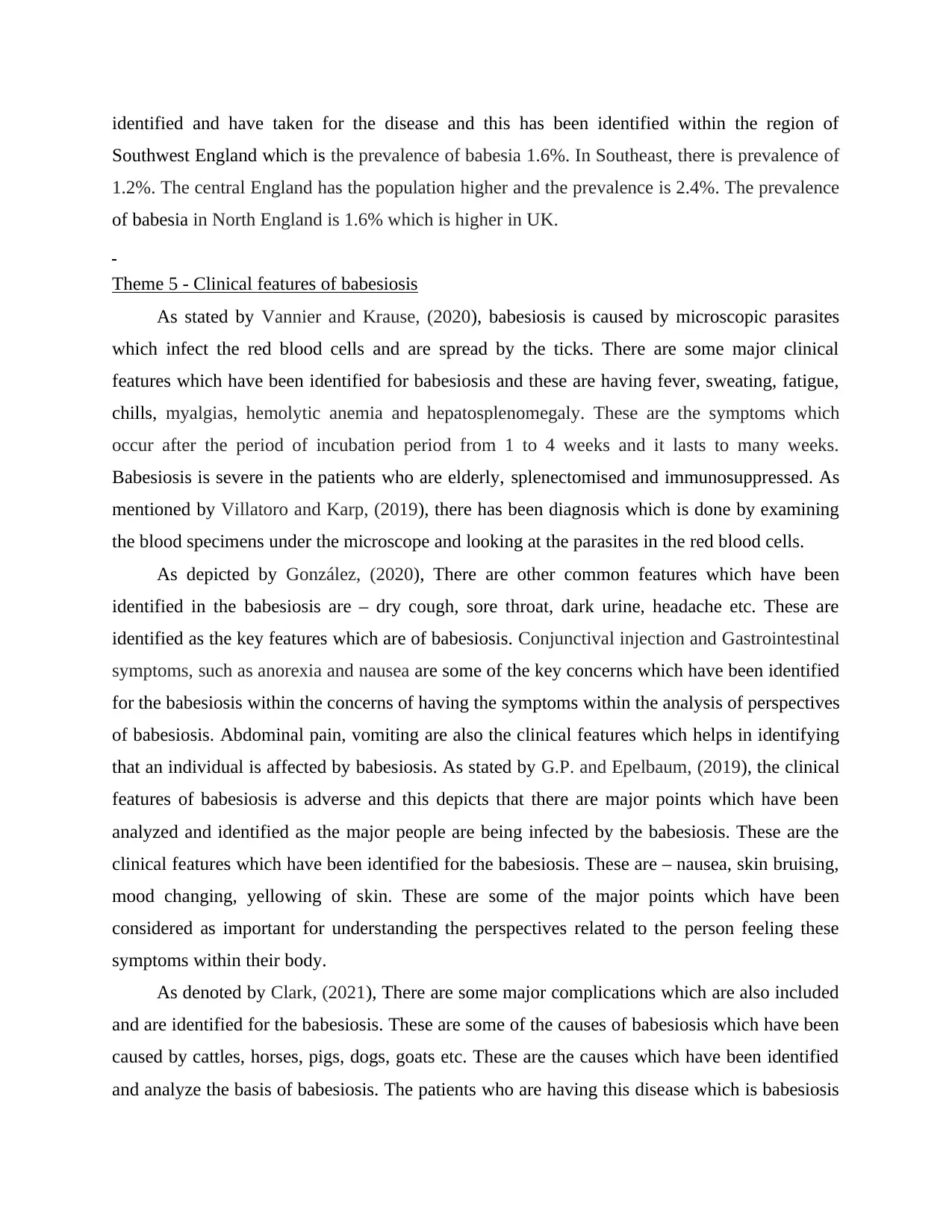
identified and have taken for the disease and this has been identified within the region of
Southwest England which is the prevalence of babesia 1.6%. In Southeast, there is prevalence of
1.2%. The central England has the population higher and the prevalence is 2.4%. The prevalence
of babesia in North England is 1.6% which is higher in UK.
Theme 5 - Clinical features of babesiosis
As stated by Vannier and Krause, (2020), babesiosis is caused by microscopic parasites
which infect the red blood cells and are spread by the ticks. There are some major clinical
features which have been identified for babesiosis and these are having fever, sweating, fatigue,
chills, myalgias, hemolytic anemia and hepatosplenomegaly. These are the symptoms which
occur after the period of incubation period from 1 to 4 weeks and it lasts to many weeks.
Babesiosis is severe in the patients who are elderly, splenectomised and immunosuppressed. As
mentioned by Villatoro and Karp, (2019), there has been diagnosis which is done by examining
the blood specimens under the microscope and looking at the parasites in the red blood cells.
As depicted by González, (2020), There are other common features which have been
identified in the babesiosis are – dry cough, sore throat, dark urine, headache etc. These are
identified as the key features which are of babesiosis. Conjunctival injection and Gastrointestinal
symptoms, such as anorexia and nausea are some of the key concerns which have been identified
for the babesiosis within the concerns of having the symptoms within the analysis of perspectives
of babesiosis. Abdominal pain, vomiting are also the clinical features which helps in identifying
that an individual is affected by babesiosis. As stated by G.P. and Epelbaum, (2019), the clinical
features of babesiosis is adverse and this depicts that there are major points which have been
analyzed and identified as the major people are being infected by the babesiosis. These are the
clinical features which have been identified for the babesiosis. These are – nausea, skin bruising,
mood changing, yellowing of skin. These are some of the major points which have been
considered as important for understanding the perspectives related to the person feeling these
symptoms within their body.
As denoted by Clark, (2021), There are some major complications which are also included
and are identified for the babesiosis. These are some of the causes of babesiosis which have been
caused by cattles, horses, pigs, dogs, goats etc. These are the causes which have been identified
and analyze the basis of babesiosis. The patients who are having this disease which is babesiosis
Southwest England which is the prevalence of babesia 1.6%. In Southeast, there is prevalence of
1.2%. The central England has the population higher and the prevalence is 2.4%. The prevalence
of babesia in North England is 1.6% which is higher in UK.
Theme 5 - Clinical features of babesiosis
As stated by Vannier and Krause, (2020), babesiosis is caused by microscopic parasites
which infect the red blood cells and are spread by the ticks. There are some major clinical
features which have been identified for babesiosis and these are having fever, sweating, fatigue,
chills, myalgias, hemolytic anemia and hepatosplenomegaly. These are the symptoms which
occur after the period of incubation period from 1 to 4 weeks and it lasts to many weeks.
Babesiosis is severe in the patients who are elderly, splenectomised and immunosuppressed. As
mentioned by Villatoro and Karp, (2019), there has been diagnosis which is done by examining
the blood specimens under the microscope and looking at the parasites in the red blood cells.
As depicted by González, (2020), There are other common features which have been
identified in the babesiosis are – dry cough, sore throat, dark urine, headache etc. These are
identified as the key features which are of babesiosis. Conjunctival injection and Gastrointestinal
symptoms, such as anorexia and nausea are some of the key concerns which have been identified
for the babesiosis within the concerns of having the symptoms within the analysis of perspectives
of babesiosis. Abdominal pain, vomiting are also the clinical features which helps in identifying
that an individual is affected by babesiosis. As stated by G.P. and Epelbaum, (2019), the clinical
features of babesiosis is adverse and this depicts that there are major points which have been
analyzed and identified as the major people are being infected by the babesiosis. These are the
clinical features which have been identified for the babesiosis. These are – nausea, skin bruising,
mood changing, yellowing of skin. These are some of the major points which have been
considered as important for understanding the perspectives related to the person feeling these
symptoms within their body.
As denoted by Clark, (2021), There are some major complications which are also included
and are identified for the babesiosis. These are some of the causes of babesiosis which have been
caused by cattles, horses, pigs, dogs, goats etc. These are the causes which have been identified
and analyze the basis of babesiosis. The patients who are having this disease which is babesiosis
Paraphrase This Document
Need a fresh take? Get an instant paraphrase of this document with our AI Paraphraser
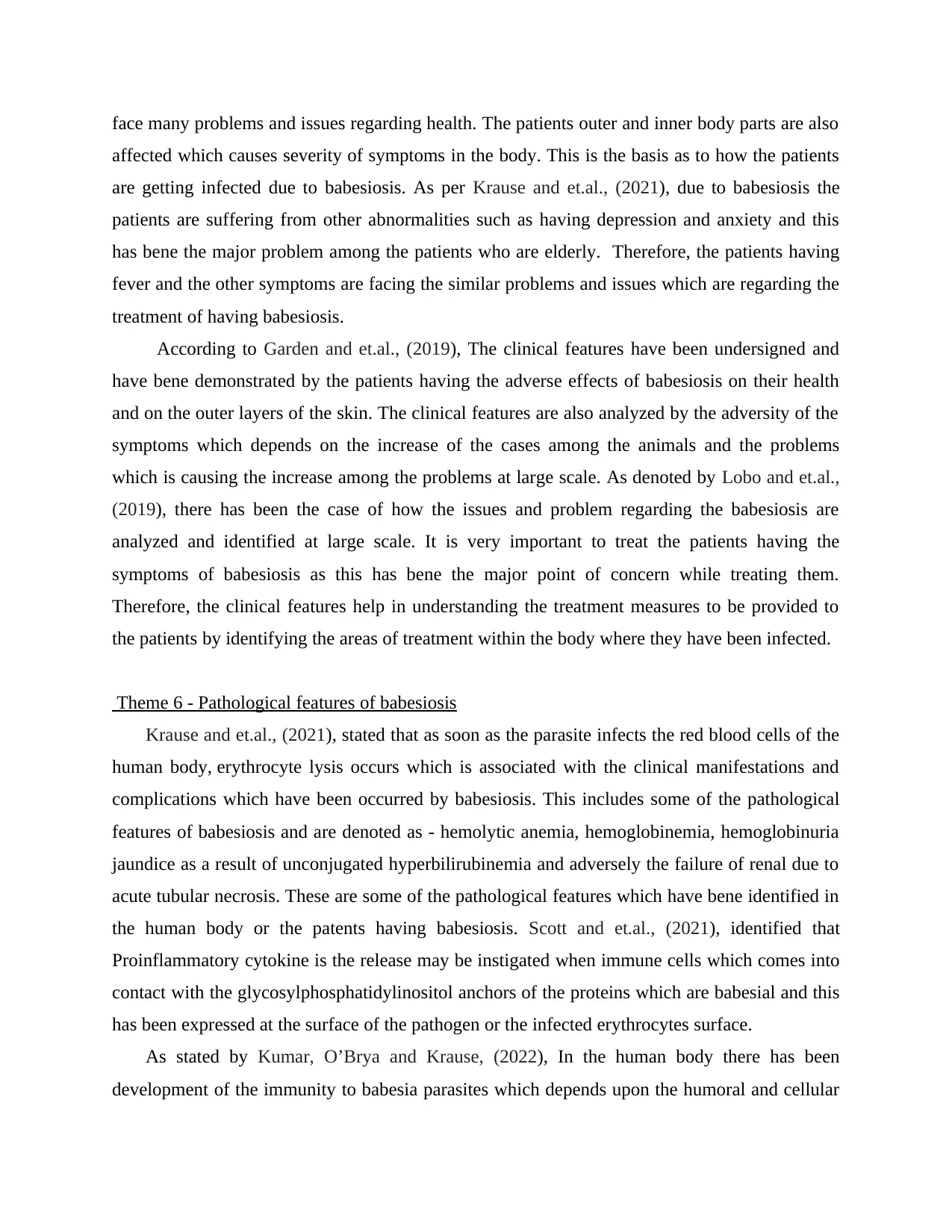
face many problems and issues regarding health. The patients outer and inner body parts are also
affected which causes severity of symptoms in the body. This is the basis as to how the patients
are getting infected due to babesiosis. As per Krause and et.al., (2021), due to babesiosis the
patients are suffering from other abnormalities such as having depression and anxiety and this
has bene the major problem among the patients who are elderly. Therefore, the patients having
fever and the other symptoms are facing the similar problems and issues which are regarding the
treatment of having babesiosis.
According to Garden and et.al., (2019), The clinical features have been undersigned and
have bene demonstrated by the patients having the adverse effects of babesiosis on their health
and on the outer layers of the skin. The clinical features are also analyzed by the adversity of the
symptoms which depends on the increase of the cases among the animals and the problems
which is causing the increase among the problems at large scale. As denoted by Lobo and et.al.,
(2019), there has been the case of how the issues and problem regarding the babesiosis are
analyzed and identified at large scale. It is very important to treat the patients having the
symptoms of babesiosis as this has bene the major point of concern while treating them.
Therefore, the clinical features help in understanding the treatment measures to be provided to
the patients by identifying the areas of treatment within the body where they have been infected.
Theme 6 - Pathological features of babesiosis
Krause and et.al., (2021), stated that as soon as the parasite infects the red blood cells of the
human body, erythrocyte lysis occurs which is associated with the clinical manifestations and
complications which have been occurred by babesiosis. This includes some of the pathological
features of babesiosis and are denoted as - hemolytic anemia, hemoglobinemia, hemoglobinuria
jaundice as a result of unconjugated hyperbilirubinemia and adversely the failure of renal due to
acute tubular necrosis. These are some of the pathological features which have bene identified in
the human body or the patents having babesiosis. Scott and et.al., (2021), identified that
Proinflammatory cytokine is the release may be instigated when immune cells which comes into
contact with the glycosylphosphatidylinositol anchors of the proteins which are babesial and this
has been expressed at the surface of the pathogen or the infected erythrocytes surface.
As stated by Kumar, O’Brya and Krause, (2022), In the human body there has been
development of the immunity to babesia parasites which depends upon the humoral and cellular
affected which causes severity of symptoms in the body. This is the basis as to how the patients
are getting infected due to babesiosis. As per Krause and et.al., (2021), due to babesiosis the
patients are suffering from other abnormalities such as having depression and anxiety and this
has bene the major problem among the patients who are elderly. Therefore, the patients having
fever and the other symptoms are facing the similar problems and issues which are regarding the
treatment of having babesiosis.
According to Garden and et.al., (2019), The clinical features have been undersigned and
have bene demonstrated by the patients having the adverse effects of babesiosis on their health
and on the outer layers of the skin. The clinical features are also analyzed by the adversity of the
symptoms which depends on the increase of the cases among the animals and the problems
which is causing the increase among the problems at large scale. As denoted by Lobo and et.al.,
(2019), there has been the case of how the issues and problem regarding the babesiosis are
analyzed and identified at large scale. It is very important to treat the patients having the
symptoms of babesiosis as this has bene the major point of concern while treating them.
Therefore, the clinical features help in understanding the treatment measures to be provided to
the patients by identifying the areas of treatment within the body where they have been infected.
Theme 6 - Pathological features of babesiosis
Krause and et.al., (2021), stated that as soon as the parasite infects the red blood cells of the
human body, erythrocyte lysis occurs which is associated with the clinical manifestations and
complications which have been occurred by babesiosis. This includes some of the pathological
features of babesiosis and are denoted as - hemolytic anemia, hemoglobinemia, hemoglobinuria
jaundice as a result of unconjugated hyperbilirubinemia and adversely the failure of renal due to
acute tubular necrosis. These are some of the pathological features which have bene identified in
the human body or the patents having babesiosis. Scott and et.al., (2021), identified that
Proinflammatory cytokine is the release may be instigated when immune cells which comes into
contact with the glycosylphosphatidylinositol anchors of the proteins which are babesial and this
has been expressed at the surface of the pathogen or the infected erythrocytes surface.
As stated by Kumar, O’Brya and Krause, (2022), In the human body there has been
development of the immunity to babesia parasites which depends upon the humoral and cellular

factors at large scale. Apart from this, there are some of the evidences which are in bulk which
proves and shows that the latter is of limited significance. There has been role of antibodies
which is restricted in the period where the parasites have found their way to the bloodstream but
they have not become intracellular. As signified by Patel, (2022), the T cells are therefore
considered as pivotal which are in the development of resistance to the parasites of babesia
among which the CD4+ T helper cell subpopulation as the main player. Moreover, there are mon
specific responses which are identified within the regard of via macrophages and natural killer
cells which are in resistance to infection of babesial.
As denoted by Bastos and et.al., (2022), babesiosis is observed by the clinical doctors as
infectious disease and this is containing parasites and is transmitted by the tick vectors. It has
been also identified that the pathophysiology of babesiosis that it is an acute hemolytic anemia
and is manifested by increased lactate dehydrogenase (LDH). Increased LDH increase the cases
which is related to addressing the concerns related to addressing the key measures and the
features which has been identified at large scale. There is decrease in the haemoglobin in more
severe cases of babesiosis.
Chen and et.al., (2019), views that babesiosis impairs with the T cell function and this is
indicative of the point that malaria, serum protein electrophoresis reflect the basis of
compensatory B cell hyperactivity. There has been analysis of how effectively the babesiosis
pathological features are analysed in effective manner. It has been identified that there are
aspects related to treating the patients with the adversities due to the disease called babesiosis.
This has been analysed as having considering the perspectives related to identifying the features
which are related to solving the patients’ problems so that they are not infected by one another
and majorly infected from the dogs, cattle, etc. Babesiosis is the major disease which has been
spreading in the animals and is then spread into the bodies of human beings.
Karshima, Karshima and Ahmed, (2022), stated that it is very important to identify the
concerns related to curing the patients of babesiosis. This has been the aspects related to
identifying the process of treatments to the symptoms and features which is spreading at such
vast scale among the people form the animals. This is acknowledged within the perspective of
treating the humans so that there is no spread of babesiosis within the human body and are not
infected at large scale. It is thus very important to idealize and find the ways to treat the disease
so that there is no major spread in the human body.
proves and shows that the latter is of limited significance. There has been role of antibodies
which is restricted in the period where the parasites have found their way to the bloodstream but
they have not become intracellular. As signified by Patel, (2022), the T cells are therefore
considered as pivotal which are in the development of resistance to the parasites of babesia
among which the CD4+ T helper cell subpopulation as the main player. Moreover, there are mon
specific responses which are identified within the regard of via macrophages and natural killer
cells which are in resistance to infection of babesial.
As denoted by Bastos and et.al., (2022), babesiosis is observed by the clinical doctors as
infectious disease and this is containing parasites and is transmitted by the tick vectors. It has
been also identified that the pathophysiology of babesiosis that it is an acute hemolytic anemia
and is manifested by increased lactate dehydrogenase (LDH). Increased LDH increase the cases
which is related to addressing the concerns related to addressing the key measures and the
features which has been identified at large scale. There is decrease in the haemoglobin in more
severe cases of babesiosis.
Chen and et.al., (2019), views that babesiosis impairs with the T cell function and this is
indicative of the point that malaria, serum protein electrophoresis reflect the basis of
compensatory B cell hyperactivity. There has been analysis of how effectively the babesiosis
pathological features are analysed in effective manner. It has been identified that there are
aspects related to treating the patients with the adversities due to the disease called babesiosis.
This has been analysed as having considering the perspectives related to identifying the features
which are related to solving the patients’ problems so that they are not infected by one another
and majorly infected from the dogs, cattle, etc. Babesiosis is the major disease which has been
spreading in the animals and is then spread into the bodies of human beings.
Karshima, Karshima and Ahmed, (2022), stated that it is very important to identify the
concerns related to curing the patients of babesiosis. This has been the aspects related to
identifying the process of treatments to the symptoms and features which is spreading at such
vast scale among the people form the animals. This is acknowledged within the perspective of
treating the humans so that there is no spread of babesiosis within the human body and are not
infected at large scale. It is thus very important to idealize and find the ways to treat the disease
so that there is no major spread in the human body.
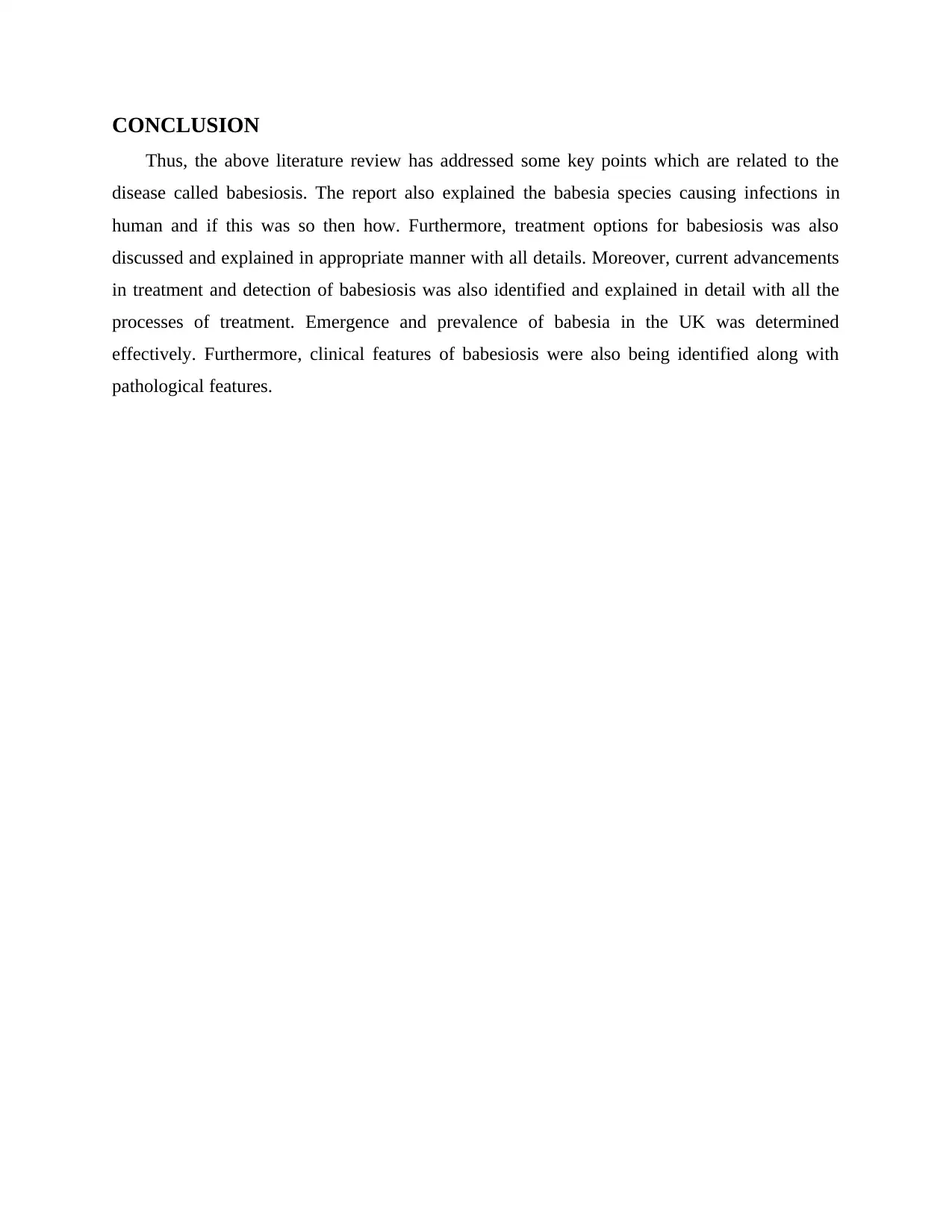
CONCLUSION
Thus, the above literature review has addressed some key points which are related to the
disease called babesiosis. The report also explained the babesia species causing infections in
human and if this was so then how. Furthermore, treatment options for babesiosis was also
discussed and explained in appropriate manner with all details. Moreover, current advancements
in treatment and detection of babesiosis was also identified and explained in detail with all the
processes of treatment. Emergence and prevalence of babesia in the UK was determined
effectively. Furthermore, clinical features of babesiosis were also being identified along with
pathological features.
Thus, the above literature review has addressed some key points which are related to the
disease called babesiosis. The report also explained the babesia species causing infections in
human and if this was so then how. Furthermore, treatment options for babesiosis was also
discussed and explained in appropriate manner with all details. Moreover, current advancements
in treatment and detection of babesiosis was also identified and explained in detail with all the
processes of treatment. Emergence and prevalence of babesia in the UK was determined
effectively. Furthermore, clinical features of babesiosis were also being identified along with
pathological features.
Secure Best Marks with AI Grader
Need help grading? Try our AI Grader for instant feedback on your assignments.
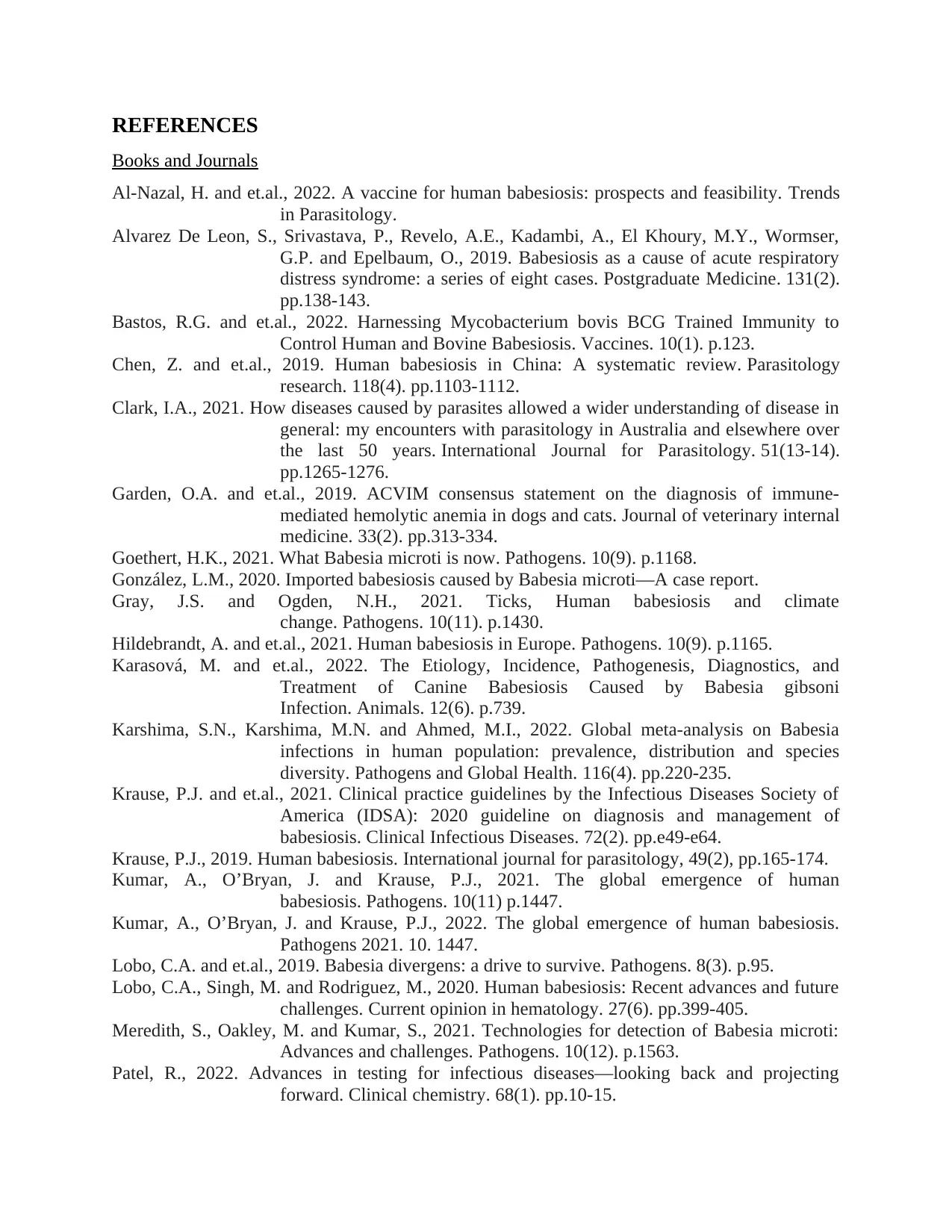
REFERENCES
Books and Journals
Al-Nazal, H. and et.al., 2022. A vaccine for human babesiosis: prospects and feasibility. Trends
in Parasitology.
Alvarez De Leon, S., Srivastava, P., Revelo, A.E., Kadambi, A., El Khoury, M.Y., Wormser,
G.P. and Epelbaum, O., 2019. Babesiosis as a cause of acute respiratory
distress syndrome: a series of eight cases. Postgraduate Medicine. 131(2).
pp.138-143.
Bastos, R.G. and et.al., 2022. Harnessing Mycobacterium bovis BCG Trained Immunity to
Control Human and Bovine Babesiosis. Vaccines. 10(1). p.123.
Chen, Z. and et.al., 2019. Human babesiosis in China: A systematic review. Parasitology
research. 118(4). pp.1103-1112.
Clark, I.A., 2021. How diseases caused by parasites allowed a wider understanding of disease in
general: my encounters with parasitology in Australia and elsewhere over
the last 50 years. International Journal for Parasitology. 51(13-14).
pp.1265-1276.
Garden, O.A. and et.al., 2019. ACVIM consensus statement on the diagnosis of immune‐
mediated hemolytic anemia in dogs and cats. Journal of veterinary internal
medicine. 33(2). pp.313-334.
Goethert, H.K., 2021. What Babesia microti is now. Pathogens. 10(9). p.1168.
González, L.M., 2020. Imported babesiosis caused by Babesia microti—A case report.
Gray, J.S. and Ogden, N.H., 2021. Ticks, Human babesiosis and climate
change. Pathogens. 10(11). p.1430.
Hildebrandt, A. and et.al., 2021. Human babesiosis in Europe. Pathogens. 10(9). p.1165.
Karasová, M. and et.al., 2022. The Etiology, Incidence, Pathogenesis, Diagnostics, and
Treatment of Canine Babesiosis Caused by Babesia gibsoni
Infection. Animals. 12(6). p.739.
Karshima, S.N., Karshima, M.N. and Ahmed, M.I., 2022. Global meta-analysis on Babesia
infections in human population: prevalence, distribution and species
diversity. Pathogens and Global Health. 116(4). pp.220-235.
Krause, P.J. and et.al., 2021. Clinical practice guidelines by the Infectious Diseases Society of
America (IDSA): 2020 guideline on diagnosis and management of
babesiosis. Clinical Infectious Diseases. 72(2). pp.e49-e64.
Krause, P.J., 2019. Human babesiosis. International journal for parasitology, 49(2), pp.165-174.
Kumar, A., O’Bryan, J. and Krause, P.J., 2021. The global emergence of human
babesiosis. Pathogens. 10(11) p.1447.
Kumar, A., O’Bryan, J. and Krause, P.J., 2022. The global emergence of human babesiosis.
Pathogens 2021. 10. 1447.
Lobo, C.A. and et.al., 2019. Babesia divergens: a drive to survive. Pathogens. 8(3). p.95.
Lobo, C.A., Singh, M. and Rodriguez, M., 2020. Human babesiosis: Recent advances and future
challenges. Current opinion in hematology. 27(6). pp.399-405.
Meredith, S., Oakley, M. and Kumar, S., 2021. Technologies for detection of Babesia microti:
Advances and challenges. Pathogens. 10(12). p.1563.
Patel, R., 2022. Advances in testing for infectious diseases—looking back and projecting
forward. Clinical chemistry. 68(1). pp.10-15.
Books and Journals
Al-Nazal, H. and et.al., 2022. A vaccine for human babesiosis: prospects and feasibility. Trends
in Parasitology.
Alvarez De Leon, S., Srivastava, P., Revelo, A.E., Kadambi, A., El Khoury, M.Y., Wormser,
G.P. and Epelbaum, O., 2019. Babesiosis as a cause of acute respiratory
distress syndrome: a series of eight cases. Postgraduate Medicine. 131(2).
pp.138-143.
Bastos, R.G. and et.al., 2022. Harnessing Mycobacterium bovis BCG Trained Immunity to
Control Human and Bovine Babesiosis. Vaccines. 10(1). p.123.
Chen, Z. and et.al., 2019. Human babesiosis in China: A systematic review. Parasitology
research. 118(4). pp.1103-1112.
Clark, I.A., 2021. How diseases caused by parasites allowed a wider understanding of disease in
general: my encounters with parasitology in Australia and elsewhere over
the last 50 years. International Journal for Parasitology. 51(13-14).
pp.1265-1276.
Garden, O.A. and et.al., 2019. ACVIM consensus statement on the diagnosis of immune‐
mediated hemolytic anemia in dogs and cats. Journal of veterinary internal
medicine. 33(2). pp.313-334.
Goethert, H.K., 2021. What Babesia microti is now. Pathogens. 10(9). p.1168.
González, L.M., 2020. Imported babesiosis caused by Babesia microti—A case report.
Gray, J.S. and Ogden, N.H., 2021. Ticks, Human babesiosis and climate
change. Pathogens. 10(11). p.1430.
Hildebrandt, A. and et.al., 2021. Human babesiosis in Europe. Pathogens. 10(9). p.1165.
Karasová, M. and et.al., 2022. The Etiology, Incidence, Pathogenesis, Diagnostics, and
Treatment of Canine Babesiosis Caused by Babesia gibsoni
Infection. Animals. 12(6). p.739.
Karshima, S.N., Karshima, M.N. and Ahmed, M.I., 2022. Global meta-analysis on Babesia
infections in human population: prevalence, distribution and species
diversity. Pathogens and Global Health. 116(4). pp.220-235.
Krause, P.J. and et.al., 2021. Clinical practice guidelines by the Infectious Diseases Society of
America (IDSA): 2020 guideline on diagnosis and management of
babesiosis. Clinical Infectious Diseases. 72(2). pp.e49-e64.
Krause, P.J., 2019. Human babesiosis. International journal for parasitology, 49(2), pp.165-174.
Kumar, A., O’Bryan, J. and Krause, P.J., 2021. The global emergence of human
babesiosis. Pathogens. 10(11) p.1447.
Kumar, A., O’Bryan, J. and Krause, P.J., 2022. The global emergence of human babesiosis.
Pathogens 2021. 10. 1447.
Lobo, C.A. and et.al., 2019. Babesia divergens: a drive to survive. Pathogens. 8(3). p.95.
Lobo, C.A., Singh, M. and Rodriguez, M., 2020. Human babesiosis: Recent advances and future
challenges. Current opinion in hematology. 27(6). pp.399-405.
Meredith, S., Oakley, M. and Kumar, S., 2021. Technologies for detection of Babesia microti:
Advances and challenges. Pathogens. 10(12). p.1563.
Patel, R., 2022. Advances in testing for infectious diseases—looking back and projecting
forward. Clinical chemistry. 68(1). pp.10-15.

Schnittger, L. and et.al., 2022. The Piroplasmida Babesia, Cytauxzoon, and Theileria in farm and
companion animals: Species compilation, molecular phylogeny, and
evolutionary insights. Parasitology Research. pp.1-39.
Scott, J.D. and et.al., 2021. Detection of Babesia odocoilei in humans with babesiosis
symptoms. Diagnostics. 11(6). p.947.
Shah, J.S. and Ramasamy, R., 2022. Fluorescence In Situ Hybridization (FISH) Tests for
Identifying Protozoan and Bacterial Pathogens in Infectious
Diseases. Diagnostics. 12(5). p.1286.
companion animals: Species compilation, molecular phylogeny, and
evolutionary insights. Parasitology Research. pp.1-39.
Scott, J.D. and et.al., 2021. Detection of Babesia odocoilei in humans with babesiosis
symptoms. Diagnostics. 11(6). p.947.
Shah, J.S. and Ramasamy, R., 2022. Fluorescence In Situ Hybridization (FISH) Tests for
Identifying Protozoan and Bacterial Pathogens in Infectious
Diseases. Diagnostics. 12(5). p.1286.
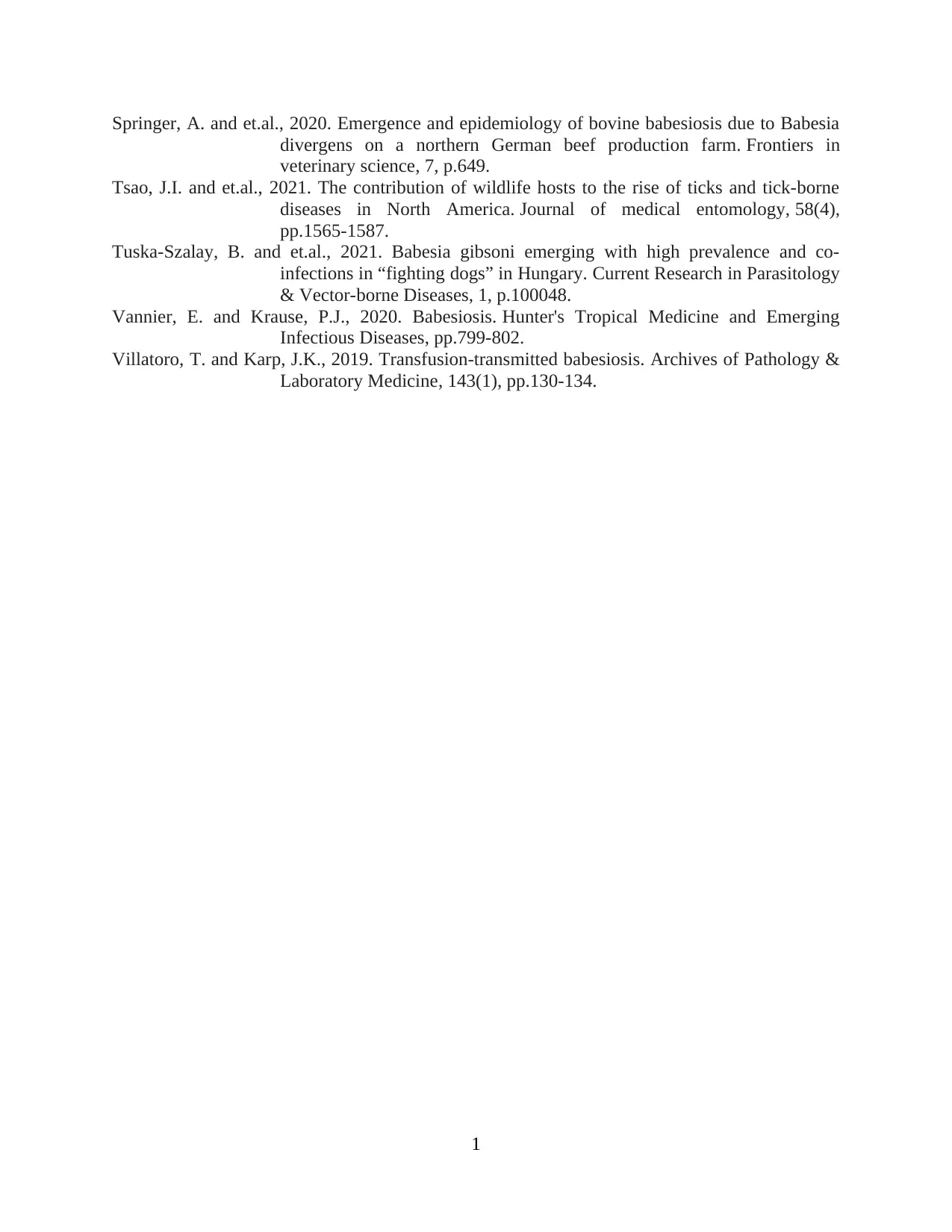
Springer, A. and et.al., 2020. Emergence and epidemiology of bovine babesiosis due to Babesia
divergens on a northern German beef production farm. Frontiers in
veterinary science, 7, p.649.
Tsao, J.I. and et.al., 2021. The contribution of wildlife hosts to the rise of ticks and tick-borne
diseases in North America. Journal of medical entomology, 58(4),
pp.1565-1587.
Tuska-Szalay, B. and et.al., 2021. Babesia gibsoni emerging with high prevalence and co-
infections in “fighting dogs” in Hungary. Current Research in Parasitology
& Vector-borne Diseases, 1, p.100048.
Vannier, E. and Krause, P.J., 2020. Babesiosis. Hunter's Tropical Medicine and Emerging
Infectious Diseases, pp.799-802.
Villatoro, T. and Karp, J.K., 2019. Transfusion-transmitted babesiosis. Archives of Pathology &
Laboratory Medicine, 143(1), pp.130-134.
1
divergens on a northern German beef production farm. Frontiers in
veterinary science, 7, p.649.
Tsao, J.I. and et.al., 2021. The contribution of wildlife hosts to the rise of ticks and tick-borne
diseases in North America. Journal of medical entomology, 58(4),
pp.1565-1587.
Tuska-Szalay, B. and et.al., 2021. Babesia gibsoni emerging with high prevalence and co-
infections in “fighting dogs” in Hungary. Current Research in Parasitology
& Vector-borne Diseases, 1, p.100048.
Vannier, E. and Krause, P.J., 2020. Babesiosis. Hunter's Tropical Medicine and Emerging
Infectious Diseases, pp.799-802.
Villatoro, T. and Karp, J.K., 2019. Transfusion-transmitted babesiosis. Archives of Pathology &
Laboratory Medicine, 143(1), pp.130-134.
1
1 out of 13
![[object Object]](/_next/static/media/star-bottom.7253800d.svg)





